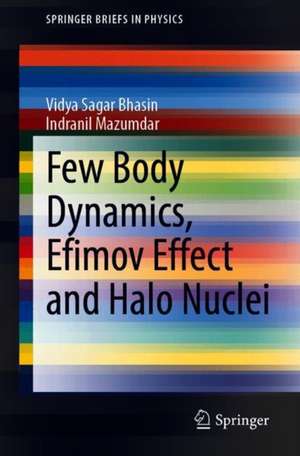Few Body Dynamics, Efimov Effect and Halo Nuclei: SpringerBriefs in Physics
Autor Vidya Sagar Bhasin, Indranil Mazumdaren Limba Engleză Paperback – 21 dec 2020
Din seria SpringerBriefs in Physics
-
 Preț: 346.92 lei
Preț: 346.92 lei -
 Preț: 381.00 lei
Preț: 381.00 lei -
 Preț: 380.07 lei
Preț: 380.07 lei -
 Preț: 200.36 lei
Preț: 200.36 lei -
 Preț: 312.68 lei
Preț: 312.68 lei -
 Preț: 476.95 lei
Preț: 476.95 lei -
 Preț: 311.69 lei
Preț: 311.69 lei -
 Preț: 394.99 lei
Preț: 394.99 lei -
 Preț: 444.74 lei
Preț: 444.74 lei - 17%
 Preț: 359.19 lei
Preț: 359.19 lei -
 Preț: 477.72 lei
Preț: 477.72 lei -
 Preț: 378.92 lei
Preț: 378.92 lei -
 Preț: 379.86 lei
Preț: 379.86 lei -
 Preț: 378.92 lei
Preț: 378.92 lei - 15%
 Preț: 461.73 lei
Preț: 461.73 lei -
 Preț: 413.07 lei
Preț: 413.07 lei -
 Preț: 377.18 lei
Preț: 377.18 lei - 15%
 Preț: 463.85 lei
Preț: 463.85 lei -
 Preț: 376.59 lei
Preț: 376.59 lei -
 Preț: 344.53 lei
Preț: 344.53 lei -
 Preț: 477.94 lei
Preț: 477.94 lei -
 Preț: 475.06 lei
Preț: 475.06 lei -
 Preț: 377.73 lei
Preț: 377.73 lei -
 Preț: 345.89 lei
Preț: 345.89 lei -
 Preț: 378.12 lei
Preț: 378.12 lei - 15%
 Preț: 464.18 lei
Preț: 464.18 lei -
 Preț: 376.80 lei
Preț: 376.80 lei -
 Preț: 409.43 lei
Preț: 409.43 lei -
 Preț: 374.46 lei
Preț: 374.46 lei -
 Preț: 377.57 lei
Preț: 377.57 lei -
 Preț: 380.84 lei
Preț: 380.84 lei - 20%
 Preț: 387.05 lei
Preț: 387.05 lei -
 Preț: 377.73 lei
Preț: 377.73 lei -
 Preț: 380.07 lei
Preț: 380.07 lei -
 Preț: 376.80 lei
Preț: 376.80 lei -
 Preț: 475.44 lei
Preț: 475.44 lei -
 Preț: 346.23 lei
Preț: 346.23 lei -
 Preț: 343.72 lei
Preț: 343.72 lei -
 Preț: 349.80 lei
Preț: 349.80 lei - 15%
 Preț: 463.53 lei
Preț: 463.53 lei -
 Preț: 376.04 lei
Preț: 376.04 lei -
 Preț: 376.22 lei
Preț: 376.22 lei -
 Preț: 376.80 lei
Preț: 376.80 lei -
 Preț: 475.65 lei
Preț: 475.65 lei -
 Preț: 375.07 lei
Preț: 375.07 lei - 15%
 Preț: 462.38 lei
Preț: 462.38 lei -
 Preț: 346.27 lei
Preț: 346.27 lei -
 Preț: 450.33 lei
Preț: 450.33 lei -
 Preț: 376.22 lei
Preț: 376.22 lei -
 Preț: 380.07 lei
Preț: 380.07 lei
Preț: 379.68 lei
Nou
Puncte Express: 570
Preț estimativ în valută:
72.66€ • 75.06$ • 60.47£
72.66€ • 75.06$ • 60.47£
Carte tipărită la comandă
Livrare economică 25 martie-08 aprilie
Preluare comenzi: 021 569.72.76
Specificații
ISBN-13: 9783030561703
ISBN-10: 3030561704
Pagini: 127
Ilustrații: XVII, 127 p. 38 illus., 6 illus. in color.
Dimensiuni: 155 x 235 mm
Greutate: 0.22 kg
Ediția:1st ed. 2021
Editura: Springer International Publishing
Colecția Springer
Seria SpringerBriefs in Physics
Locul publicării:Cham, Switzerland
ISBN-10: 3030561704
Pagini: 127
Ilustrații: XVII, 127 p. 38 illus., 6 illus. in color.
Dimensiuni: 155 x 235 mm
Greutate: 0.22 kg
Ediția:1st ed. 2021
Editura: Springer International Publishing
Colecția Springer
Seria SpringerBriefs in Physics
Locul publicării:Cham, Switzerland
Cuprins
Essentials of non-relativistic scattering theory.- The three-body scattering problem.- Halo nuclei.- Efimov effect.- Effective field theories and universal properties of few body systems.- Concluding remarks.
Notă biografică
Vidya Sagar Bhasin received his Ph.D in theoretical nuclear physics from University of Delhi, working on the problem of nuclear three body scattering at low energies. He has spent extended periods at ICTP, Trieste, SLAC, Stanford University, T.W. Bonner Nuclear Lab, Rice University, University of Manitoba, Winnipeg at different times as post-doctoral fellow and visiting scientist. He has been Alexander von Humboldt Fellow at the University of Bonn. He taught and carried out research at the Department of Physics and Astrophysics, University of Delhi for nearly four decades. His research interests have been in non-relativistic and relativistic three-body nuclear physic, high energy scattering problems, meson-baryon physics in quark model, charge symmetry breaking effect in nucleon-nucleon scattering, few-body analysis of structural properties of neutron-rich halo nuclei and search for Efimov effect in nuclei. He has edited several volumes on some ofthese topics and has authored several books on science and technology for the National Centre for Education Research and Training (NCERT, Govt. of India).
Indranil Mazumdar is professor of nuclear physics at the Tata Institute of Fundamental Research (TIFR), Mumbai. He studied physics at Delhi University for both his bachelor and master degrees. He received his Ph.D in nuclear physics from Delhi University having worked jointly at Delhi University and Inter University Accelerator Centre (Formerly Nuclear Science Centre ), New Delhi. He did his post-doctoral work at the State University of New York at Stony Brook, and later spent extended period on sabbatical at the Duke University, North Carolina. His research interests cover both theoretical, phenomenological calculations, experiments and instrumentation. His primary activities include few-body calculations of neutron-rich halo nuclei, Efimov effect, shape-phase transitions in hot and rotating nuclei, giant resonances, fusion-fission dynamics, nuclear level density, reactions of nuclear astrophysics and Big Bang Nucleosynthesis.
Indranil Mazumdar is professor of nuclear physics at the Tata Institute of Fundamental Research (TIFR), Mumbai. He studied physics at Delhi University for both his bachelor and master degrees. He received his Ph.D in nuclear physics from Delhi University having worked jointly at Delhi University and Inter University Accelerator Centre (Formerly Nuclear Science Centre ), New Delhi. He did his post-doctoral work at the State University of New York at Stony Brook, and later spent extended period on sabbatical at the Duke University, North Carolina. His research interests cover both theoretical, phenomenological calculations, experiments and instrumentation. His primary activities include few-body calculations of neutron-rich halo nuclei, Efimov effect, shape-phase transitions in hot and rotating nuclei, giant resonances, fusion-fission dynamics, nuclear level density, reactions of nuclear astrophysics and Big Bang Nucleosynthesis.
Caracteristici
Discusses few-body physics from its first developments to recent progress Emphasizes key methods to solve the two- and three-body scattering problem Reviews relevant state-of-the-art experimental techniques
